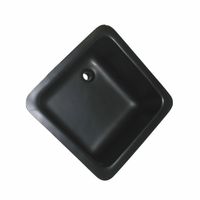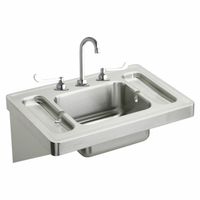Call +(254) 703 030 000 / 751 483 999 / 721 704 777
- Home
- Plumbing
- Sinks Wash Fountains Repair Parts
- Hospital Lab Sinks
Frequently Asked Questions
What are the different types of hospital and lab sinks?
Hospital and lab sinks are specialized fixtures designed to meet the stringent hygiene and functional requirements of medical and laboratory environments. Here are the different types:
1. **Handwashing Sinks**: These are designed for frequent handwashing, crucial in preventing the spread of infections. They often feature touchless faucets to minimize contamination.
2. **Scrub Sinks**: Used primarily in surgical areas, these sinks are deeper and equipped with knee or foot controls to allow surgeons to scrub in without touching the faucet.
3. **Utility Sinks**: Found in janitorial or maintenance areas, these sinks are used for cleaning equipment and disposing of waste. They are typically larger and more robust.
4. **Laboratory Sinks**: Designed to handle chemicals and biological materials, these sinks are often made from materials resistant to corrosion and staining, such as epoxy resin or stainless steel.
5. **Slop Sinks**: Used for disposing of liquid waste, these sinks are typically found in utility rooms and are designed to handle large volumes of waste.
6. **Decontamination Sinks**: Used in areas where instruments and equipment are cleaned and sterilized, these sinks often have multiple basins for different stages of cleaning.
7. **Eye Wash Sinks**: Integrated with emergency eyewash stations, these sinks provide immediate decontamination for the eyes in case of exposure to harmful substances.
8. **ADA Compliant Sinks**: Designed to be accessible to individuals with disabilities, these sinks meet specific height and clearance requirements.
Each type of sink is tailored to specific tasks and environments, ensuring safety, hygiene, and efficiency in hospital and laboratory settings.
What materials are hospital and lab sinks made from?
Hospital and lab sinks are typically made from materials that prioritize durability, hygiene, and resistance to chemicals and stains. Common materials include:
1. **Stainless Steel**: This is the most prevalent material used for hospital and lab sinks due to its corrosion resistance, ease of cleaning, and ability to withstand harsh chemicals. It is non-porous, which prevents bacterial growth, making it ideal for sterile environments.
2. **Porcelain Enamel**: Often used in areas where aesthetics are also a consideration, porcelain enamel is durable and resistant to stains and scratches. However, it can chip if heavy objects are dropped on it.
3. **Epoxy Resin**: This material is highly resistant to chemicals, heat, and moisture, making it suitable for lab environments where exposure to corrosive substances is common. It is also non-porous, reducing the risk of contamination.
4. **Polypropylene**: Known for its chemical resistance, polypropylene is used in some lab sinks. It is lightweight and can withstand a variety of chemical exposures, though it may not be as durable as stainless steel or epoxy resin.
5. **Ceramic**: While less common in labs due to its fragility, ceramic sinks are sometimes used in hospital settings for their aesthetic appeal and ease of cleaning. They are resistant to stains and scratches but can crack under impact.
6. **Solid Surface Materials**: These are made from a blend of acrylic or polyester resins and are used for their seamless appearance and resistance to bacteria and mold. They can be easily repaired if scratched or damaged.
Each material is chosen based on the specific needs of the environment, considering factors like chemical exposure, frequency of use, and the need for sterility.
How do touchless operation sinks work in healthcare settings?
Touchless operation sinks in healthcare settings work through the integration of sensor technology, which allows for hands-free operation to enhance hygiene and prevent cross-contamination. These sinks typically use infrared sensors or capacitive sensors to detect the presence of hands. When hands are placed within the sensor's range, it triggers the faucet to release water.
Infrared sensors emit a beam of light, and when hands interrupt this beam, the sensor activates the water flow. Capacitive sensors, on the other hand, detect changes in the electrical field caused by the presence of hands. Both types of sensors are designed to be highly sensitive and responsive to ensure quick activation and deactivation of water flow.
The water temperature and flow rate can be pre-set or adjusted using touchless controls, often through a digital interface or remote control. Some advanced systems incorporate thermostatic mixing valves to maintain a consistent water temperature, which is crucial in healthcare settings to prevent scalding and ensure effective handwashing.
Touchless sinks are often equipped with automatic shut-off features to conserve water and reduce the risk of overflow. They may also include self-cleaning mechanisms or antimicrobial coatings to further enhance hygiene.
In healthcare environments, these sinks are strategically placed in areas such as patient rooms, operating theaters, and laboratories to minimize the risk of infection transmission. By eliminating the need to touch faucet handles, touchless sinks help maintain a sterile environment, crucial for patient safety and infection control.
What are the benefits of using stainless steel for hospital sinks?
Stainless steel is a preferred material for hospital sinks due to its numerous benefits. Firstly, it is highly durable and resistant to corrosion, which is crucial in a hospital setting where sinks are frequently exposed to water, cleaning agents, and various chemicals. This resistance ensures a long lifespan and reduces the need for frequent replacements, making it cost-effective.
Secondly, stainless steel is non-porous and smooth, which prevents the accumulation of dirt, bacteria, and other pathogens. This characteristic is essential for maintaining high hygiene standards in hospitals, as it facilitates easy cleaning and sterilization, reducing the risk of infections.
Additionally, stainless steel is resistant to heat and can withstand high temperatures, which is beneficial for thermal disinfection processes. Its ability to endure extreme temperatures without degrading ensures that it remains a safe and reliable material for hospital environments.
Stainless steel also offers aesthetic benefits. Its sleek and modern appearance can enhance the overall look of hospital facilities, contributing to a clean and professional environment. Moreover, it is recyclable and environmentally friendly, aligning with sustainable practices increasingly adopted by healthcare institutions.
Furthermore, stainless steel is versatile and can be fabricated into various designs and sizes to meet specific hospital requirements. This adaptability allows for customization to fit different spaces and functionalities, ensuring that the sinks meet the specific needs of different hospital departments.
In summary, the benefits of using stainless steel for hospital sinks include durability, corrosion resistance, ease of cleaning, heat resistance, aesthetic appeal, environmental sustainability, and versatility, all of which contribute to maintaining a safe and efficient healthcare environment.
How do you maintain and clean lab sinks to ensure hygiene?
To maintain and clean lab sinks for hygiene, follow these steps:
1. **Daily Cleaning**: At the end of each day, clean the sink with a mild detergent and warm water. Use a non-abrasive scrubber to remove any residues. Rinse thoroughly with water.
2. **Disinfection**: After cleaning, disinfect the sink using a suitable disinfectant, such as a bleach solution (1:10 ratio of bleach to water) or a commercial disinfectant. Apply the disinfectant, let it sit for the recommended contact time, and then rinse with water.
3. **Regular Inspections**: Conduct regular inspections to check for any signs of damage, leaks, or blockages. Address any issues immediately to prevent contamination.
4. **Avoid Cross-Contamination**: Use separate cleaning tools for the sink and other lab areas. Label cleaning tools and store them properly to avoid cross-contamination.
5. **Waste Disposal**: Ensure proper disposal of chemical and biological waste. Use designated containers for hazardous waste and follow lab protocols for disposal.
6. **Drain Maintenance**: Regularly clean and maintain the sink drains. Use a drain cleaner or a mixture of baking soda and vinegar to prevent clogs and remove odors.
7. **Personal Protective Equipment (PPE)**: Wear appropriate PPE, such as gloves and goggles, during cleaning to protect against exposure to chemicals and pathogens.
8. **Documentation**: Keep a cleaning log to document cleaning schedules, products used, and any maintenance performed. This helps in tracking and ensuring compliance with hygiene standards.
9. **Training**: Ensure all lab personnel are trained in proper cleaning and maintenance procedures to maintain consistent hygiene standards.
10. **Ventilation**: Ensure proper ventilation in the lab to reduce moisture and prevent mold growth around the sink area.
By following these steps, lab sinks can be maintained in a hygienic condition, minimizing the risk of contamination and ensuring a safe working environment.
What are the installation requirements for hospital and lab sinks?
Hospital and lab sinks must meet specific installation requirements to ensure hygiene, functionality, and compliance with health and safety standards. Key requirements include:
1. **Material**: Sinks should be made from durable, non-porous materials like stainless steel or solid surface materials to resist corrosion and facilitate easy cleaning.
2. **Design**: The design should minimize crevices and joints where bacteria can accumulate. Integral or seamless sinks are preferred.
3. **Size and Depth**: Sinks must be adequately sized to accommodate the washing of large instruments and equipment. Depth should be sufficient to prevent splashing.
4. **Faucets**: Hands-free operation is essential to prevent cross-contamination. Sensor-activated, foot-operated, or elbow-operated faucets are recommended.
5. **Water Temperature Control**: Mixing valves should be installed to provide both hot and cold water, with temperature controls to prevent scalding.
6. **Backsplash**: A high backsplash is necessary to protect walls from water damage and contamination.
7. **Drainage**: Efficient drainage systems with appropriate traps and vents are required to prevent backflow and odors.
8. **Installation Height**: Sinks should be installed at a height that is ergonomic for users, typically between 32 to 34 inches from the floor.
9. **Compliance**: Installation must comply with local plumbing codes, health regulations, and ADA (Americans with Disabilities Act) requirements for accessibility.
10. **Ventilation**: Adequate ventilation should be provided to prevent moisture buildup and mold growth.
11. **Proximity to Work Areas**: Sinks should be strategically located near workstations to facilitate frequent handwashing and equipment cleaning.
12. **Waste Disposal**: Proper waste disposal systems, including biohazard waste containers, should be in place near sinks.
13. **Maintenance Access**: Ensure easy access for maintenance and repairs without disrupting hospital or lab operations.
How do hospital sinks differ from regular sinks in terms of design and functionality?
Hospital sinks differ from regular sinks in several key aspects of design and functionality to meet the stringent hygiene and safety standards required in healthcare settings.
1. **Material and Construction**: Hospital sinks are typically made from high-grade stainless steel or other non-porous materials that resist corrosion and are easy to clean. This helps prevent the growth of bacteria and other pathogens.
2. **Hands-Free Operation**: Many hospital sinks are equipped with hands-free operation mechanisms, such as foot pedals, knee levers, or sensor-activated faucets, to minimize contact and reduce the risk of cross-contamination.
3. **Deep Basins**: The basins in hospital sinks are often deeper than those in regular sinks to prevent splashing, which can spread contaminants. This design also accommodates the washing of larger medical instruments.
4. **Backsplash and Splash Guards**: Hospital sinks often include high backsplashes and side splash guards to contain water and prevent it from reaching other surfaces, thereby reducing the risk of contamination.
5. **Antimicrobial Coatings**: Some hospital sinks have antimicrobial coatings to further inhibit the growth of bacteria and other microorganisms on their surfaces.
6. **Integrated Drainage Systems**: These sinks often feature advanced drainage systems that prevent water from pooling, reducing the risk of bacterial growth and ensuring efficient water flow.
7. **Compliance with Health Standards**: Hospital sinks are designed to comply with specific health and safety standards, such as those set by the Centers for Disease Control and Prevention (CDC) or the World Health Organization (WHO), ensuring they meet the necessary requirements for infection control.
8. **Ergonomic Design**: The design of hospital sinks often considers the ergonomic needs of healthcare workers, ensuring ease of use and reducing the risk of strain or injury during frequent use.

